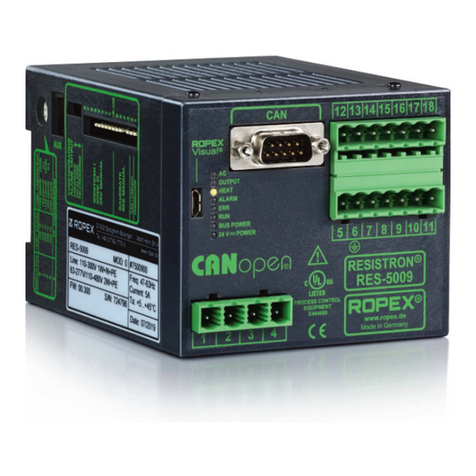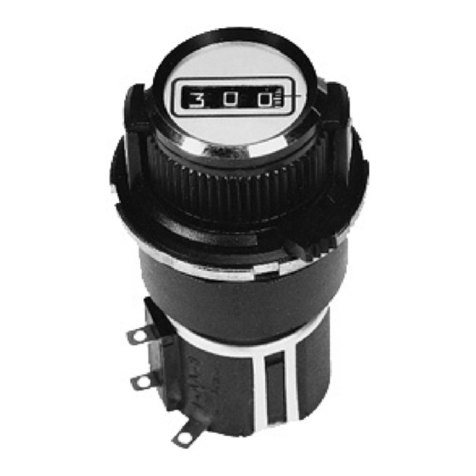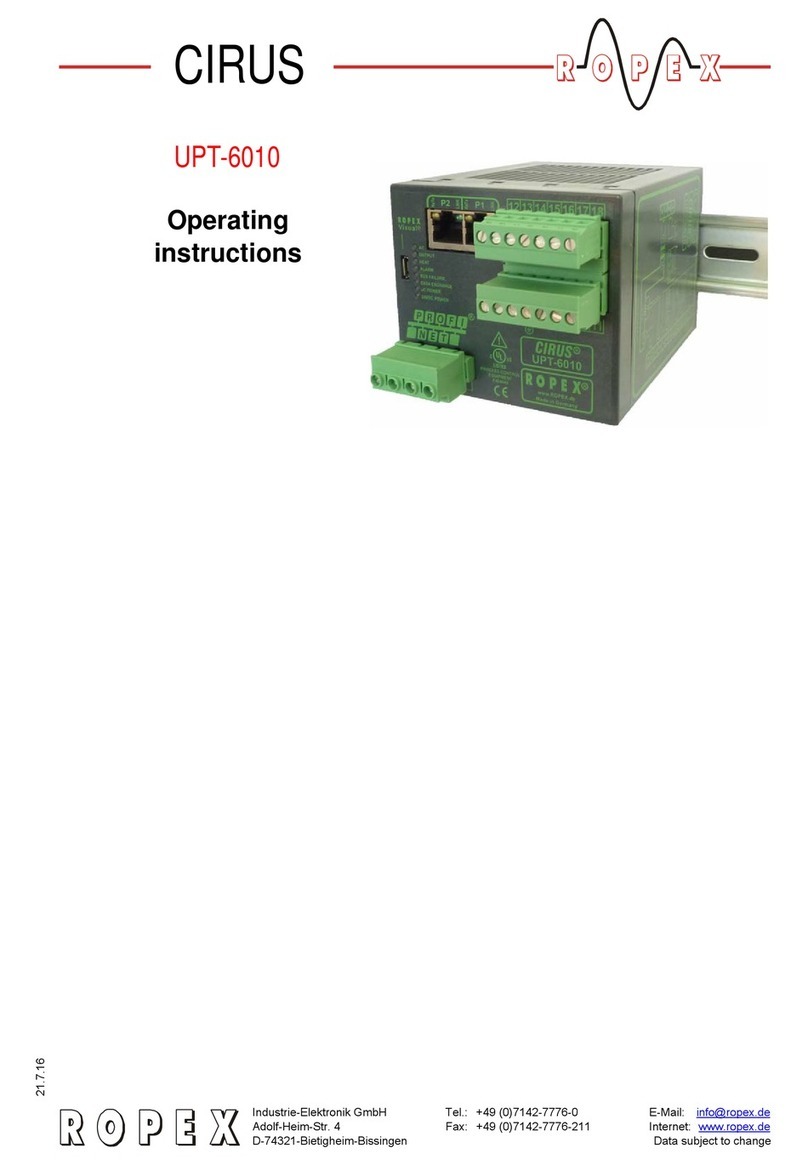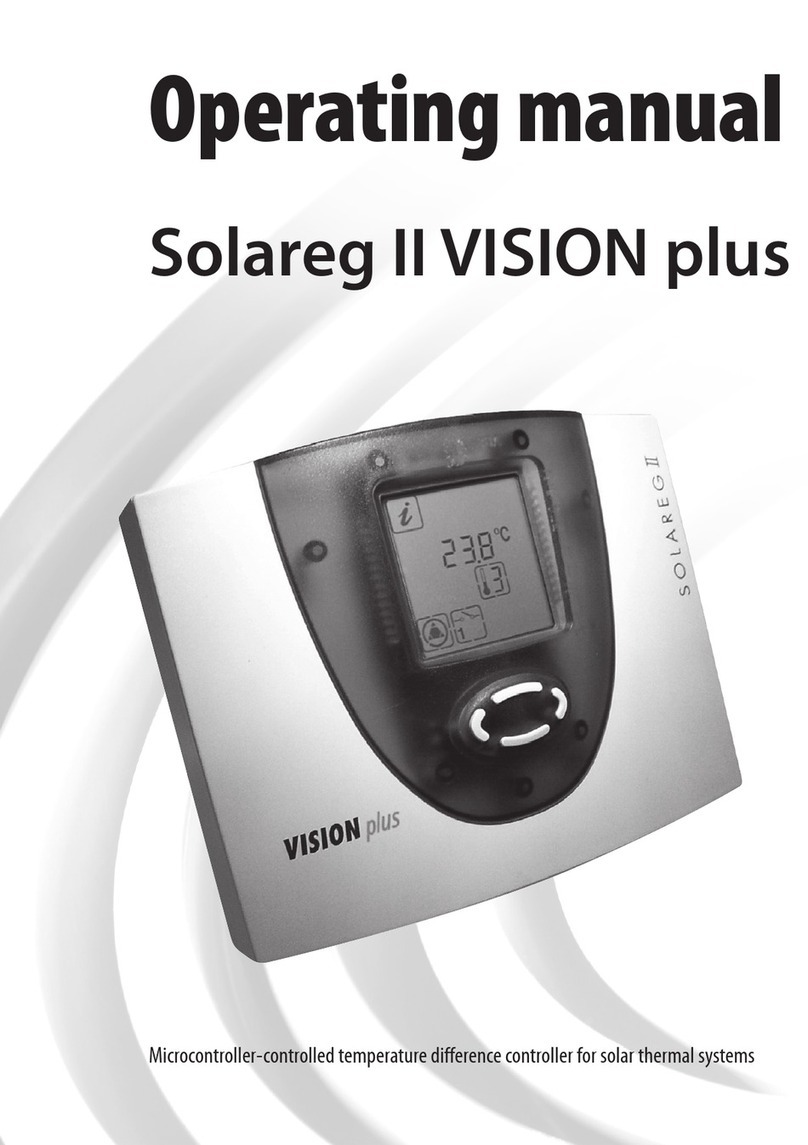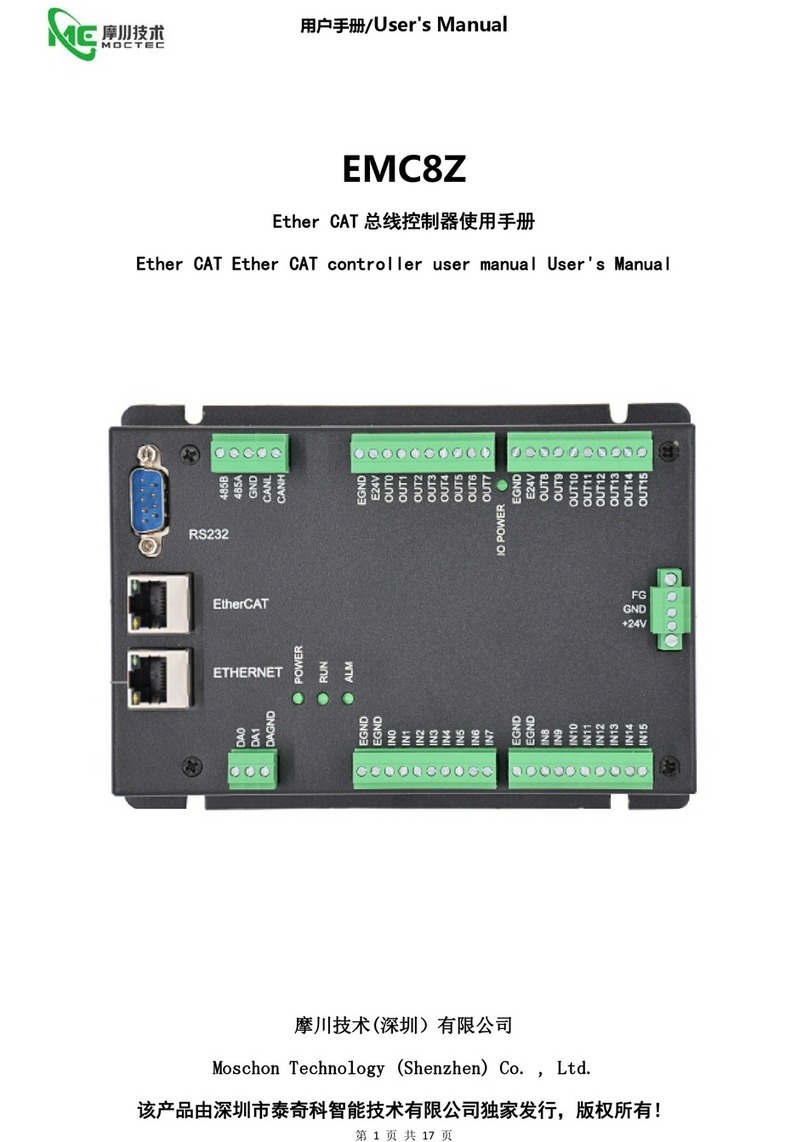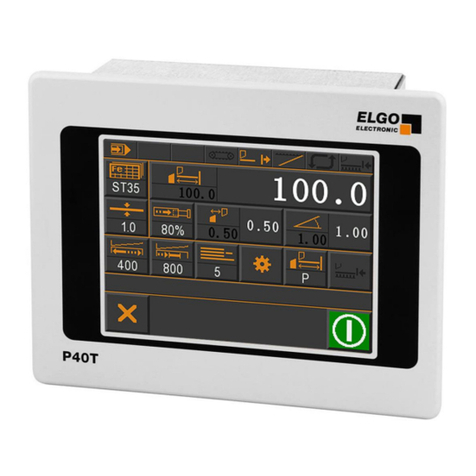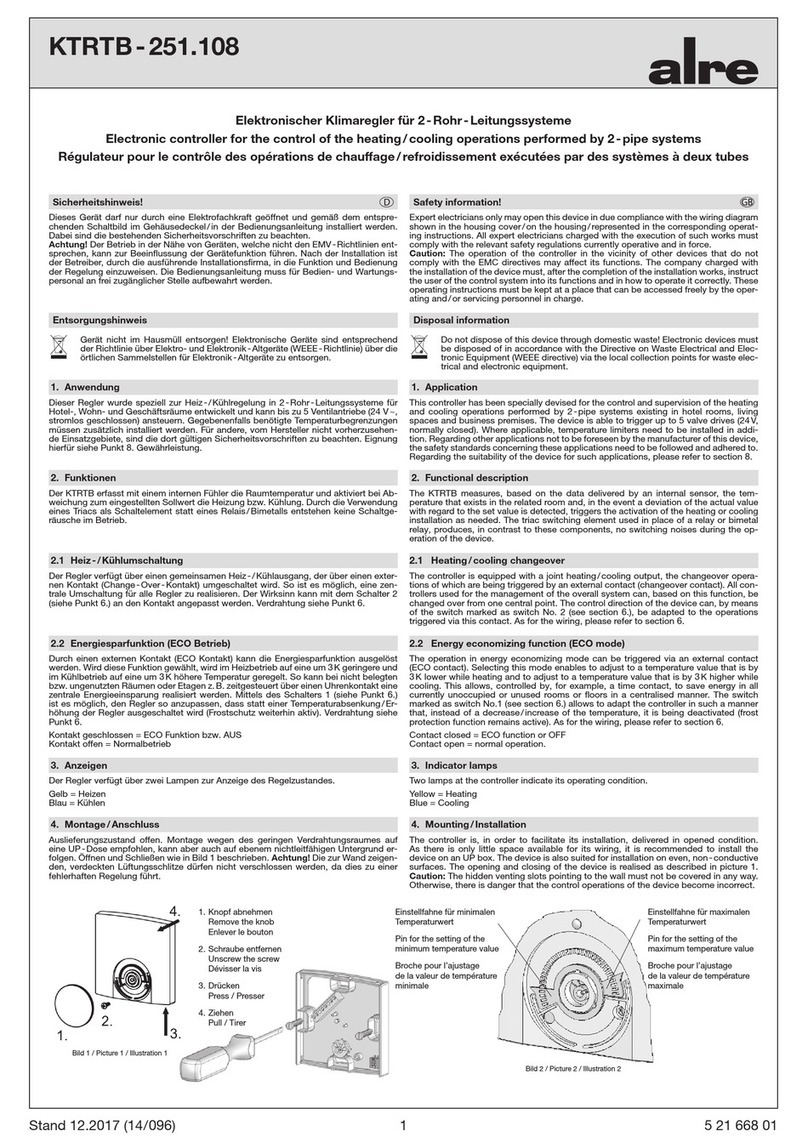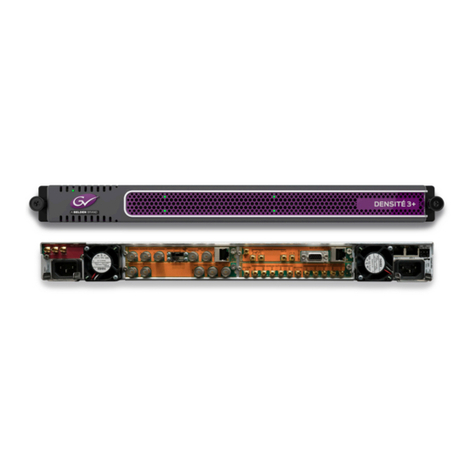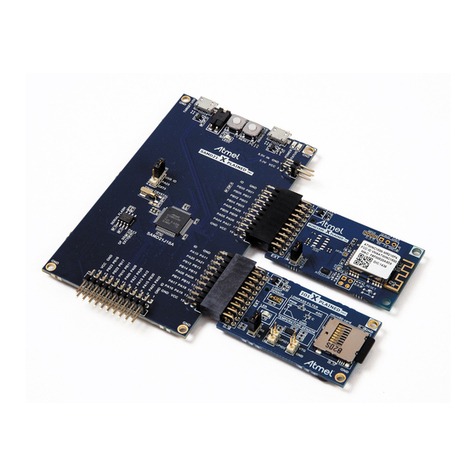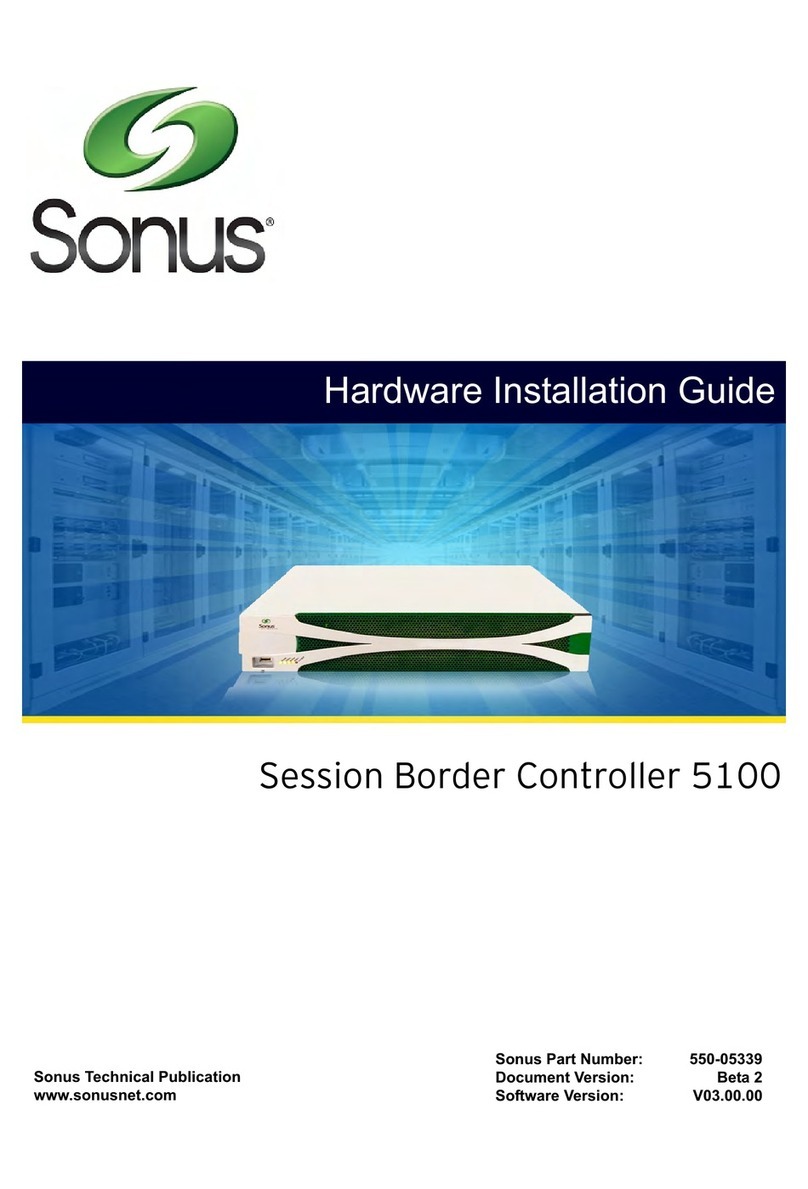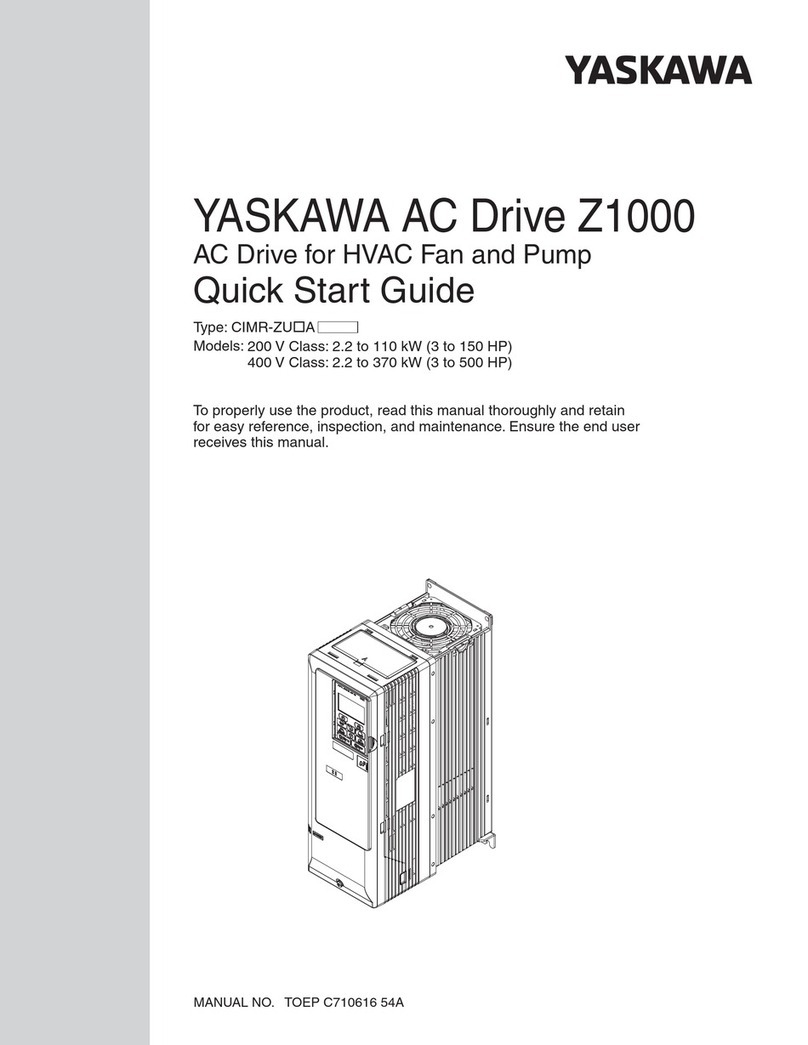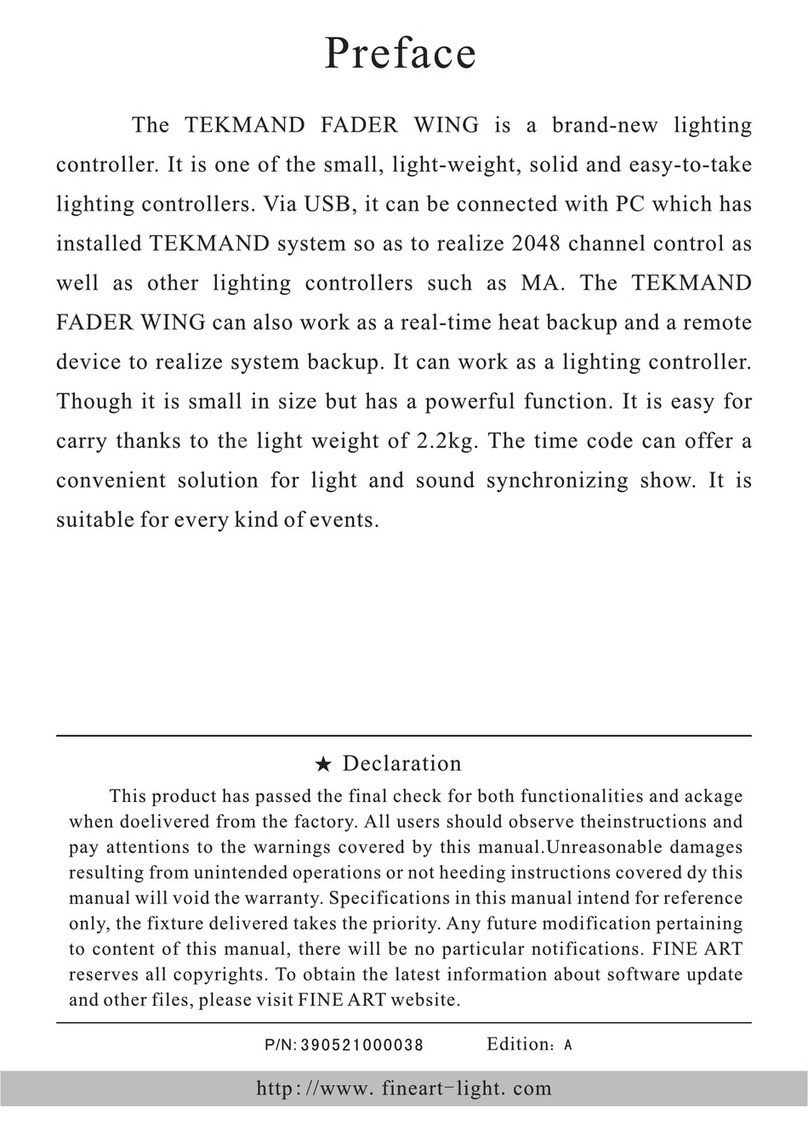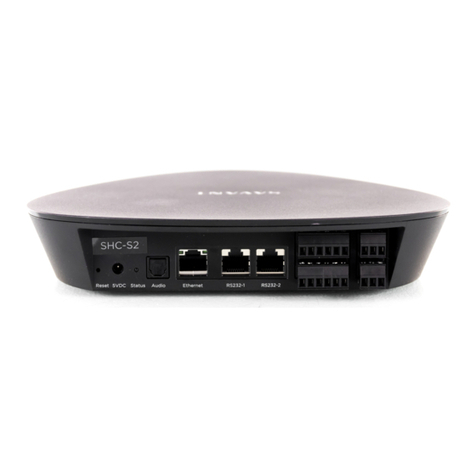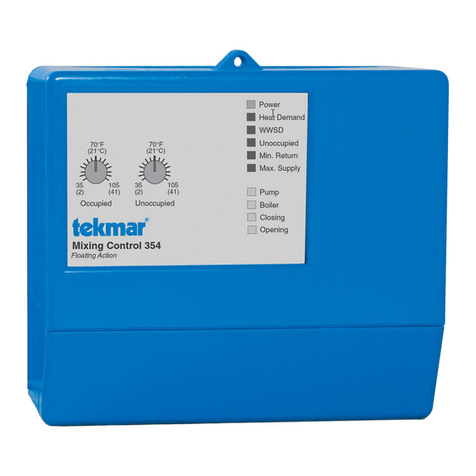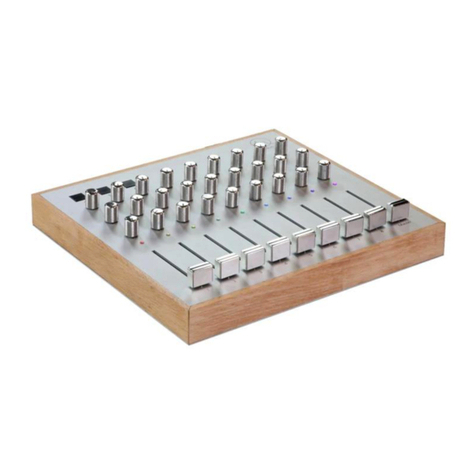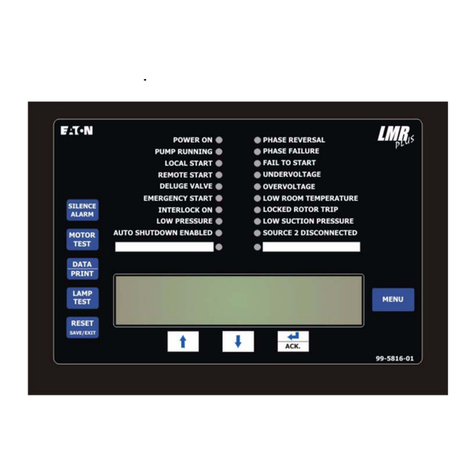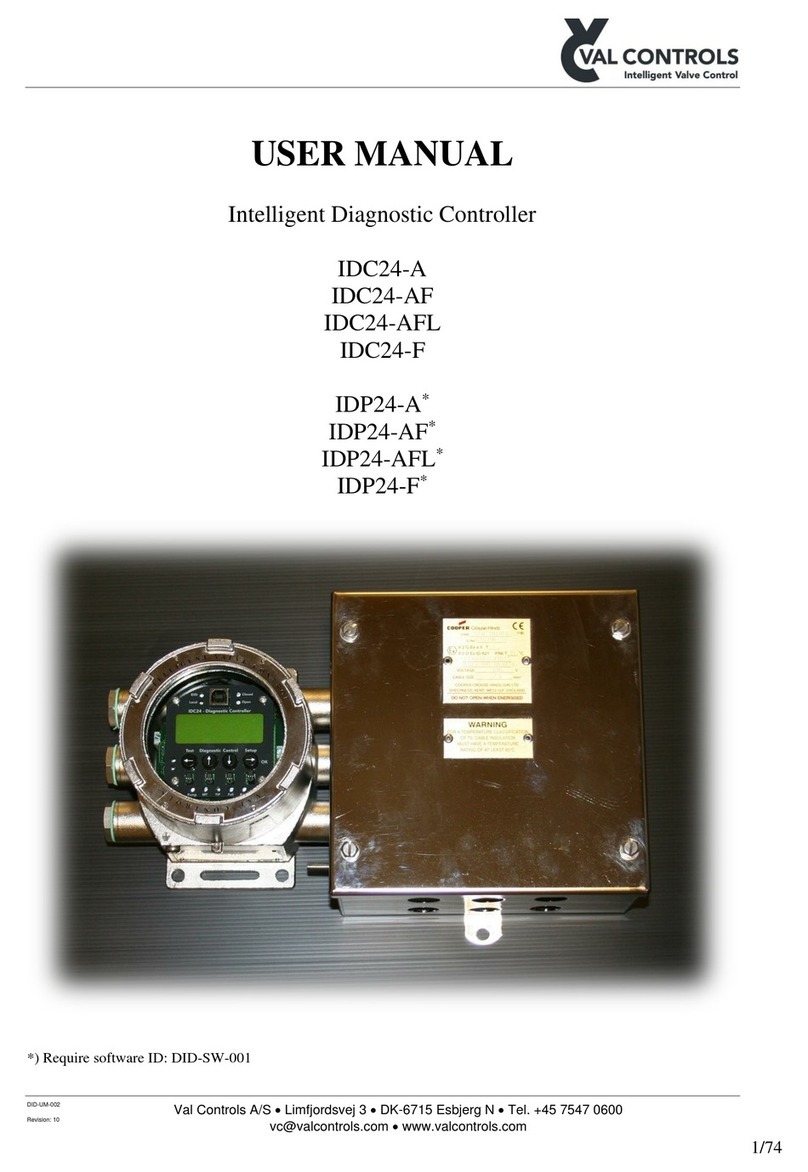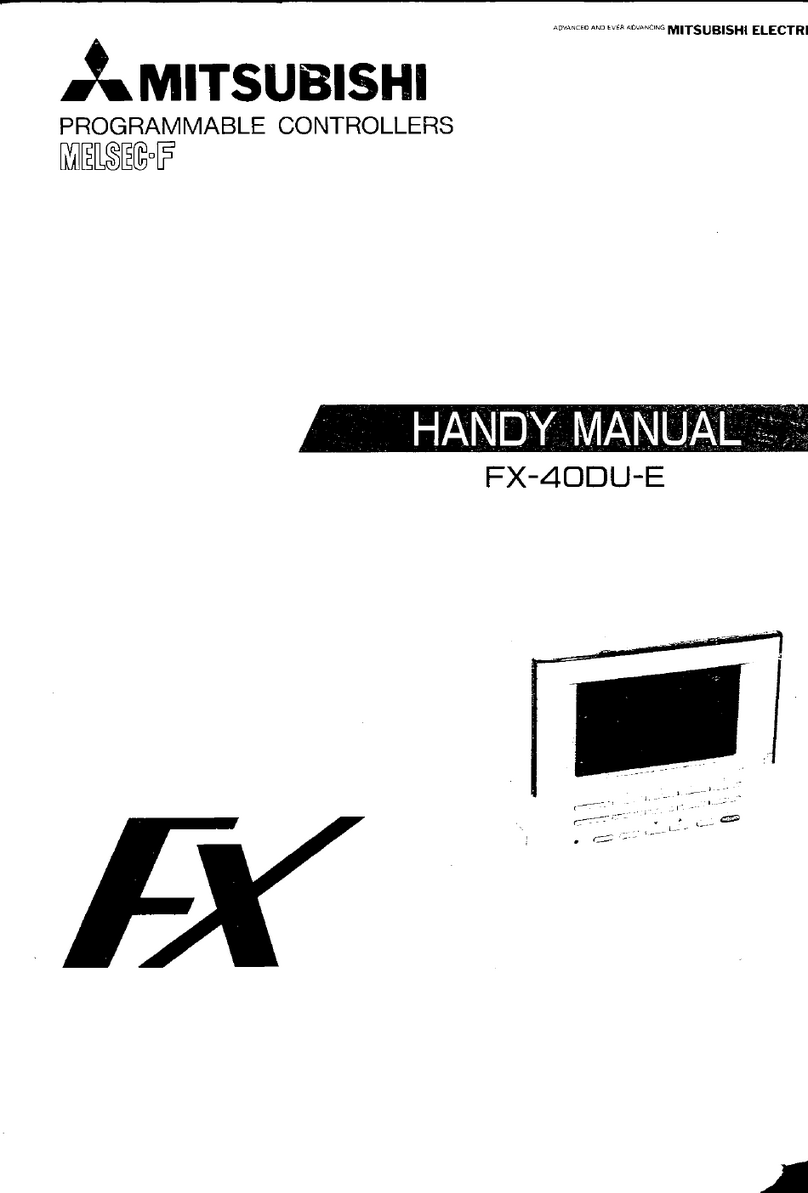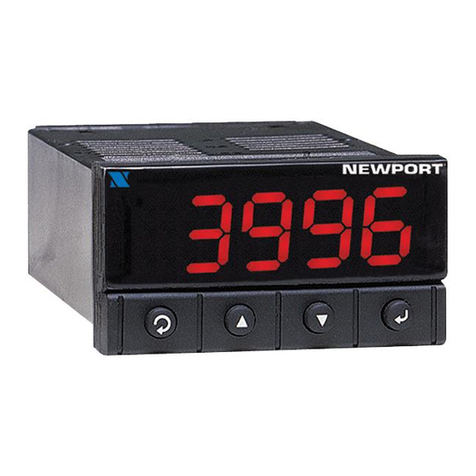Ropex Resistron RES-430 Series User manual

Gansäcker 21 Fax: +49/(0)7142/7776-19 Internet: www.ropex.de
D-74321-Bietigheim-Bissingen (Germany) Data subject to change
20.1.05
RESISTRON
RES-430 GB
Important features
• Microprocessor technology
• LC display (green), 4 lines, 20 characters (multilingual)
• Automatic zero calibration (AUTOCAL)
• Automatic optimization (AUTOTUNE)
• Automatic frequency adjustment
• Secondary control
• Heatsealing band alloy and temperature range selectable
• Time control, heatsealing time and cooling time settable
• Configurable relay output, e.g. "end of cycle"
• Time or temperature-controlled cooling phase
• 0…10VDC analog output for ACTUAL temperature
• Load cell interface for monitoring closing pressure
• Serial data interface (optional)
• Fault diagnosis
Operating
Instructions

Page 2 RES-430
Contents
1 Safety and warning notes . . . . . . . . . . . . . . 3
1.1 Use . . . . . . . . . . . . . . . . . . . . . . . . . . . 3
1.2 Heatsealing band . . . . . . . . . . . . . . . . 3
1.3 Impulse transformer . . . . . . . . . . . . . . 3
1.4 Line filter . . . . . . . . . . . . . . . . . . . . . . . 3
1.5 Warranty provisions . . . . . . . . . . . . . . . 3
1.6 Standards / CE marking . . . . . . . . . . . 4
2 Application . . . . . . . . . . . . . . . . . . . . . . . . . . 4
3 Principle of operation . . . . . . . . . . . . . . . . . 5
4 Description of the controller . . . . . . . . . . . 5
5 Modifications (MODs) /
optical data interface . . . . . . . . . . . . . . . . . . 6
5.1 Modifications . . . . . . . . . . . . . . . . . . . . 6
5.2 Optional data interface
(piggyback module) . . . . . . . . . . . . . . . 6
6 Technical data . . . . . . . . . . . . . . . . . . . . . . . 8
7 Dimensions / front panel cutout . . . . . . . . 10
7.1 Motherboard . . . . . . . . . . . . . . . . . . . 10
7.2 Display terminal . . . . . . . . . . . . . . . . . 11
8 Installation . . . . . . . . . . . . . . . . . . . . . . . . . 12
8.1 Installation procedure . . . . . . . . . . . . 12
8.2 Installation steps . . . . . . . . . . . . . . . . 12
8.3 Power supply . . . . . . . . . . . . . . . . . . . 13
8.4 Wiring diagram with relay K1
(standard) . . . . . . . . . . . . . . . . . . . . . 14
8.5 Wiring diagram with solenoid drive
(optional) . . . . . . . . . . . . . . . . . . . . . . 15
9 Startup and operation . . . . . . . . . . . . . . . . 16
9.1 View of the controller . . . . . . . . . . . . . 16
9.2 General controller configuration . . . . 17
9.3 Time control (timer function) . . . . . . . 18
9.4 Temperaturediagnosis . . . . . . . . . . . . 22
9.5 Load cell interface /
temperature sensor . . . . . . . . . . . . . . 23
9.6 Heatsealing band . . . . . . . . . . . . . . . 24
9.7 Startup procedure . . . . . . . . . . . . . . . 25
10 Controller functions . . . . . . . . . . . . . . . . . 27
10.1 Indicators and controls . . . . . . . . . . . 27
10.2 Display . . . . . . . . . . . . . . . . . . . . . . . . 27
10.3 Navigation in the menus . . . . . . . . . . 29
10.4 Menu structure . . . . . . . . . . . . . . . . . . 31
10.5 Two-digit numbering system
up to SW revision 006 . . . . . . . . . . . . 33
10.6 Temperature setting
(set point selection) . . . . . . . . . . . . . . 34
10.7 Temperature indication /
actual value output . . . . . . . . . . . . . . 34
10.8 Automatic zero calibration
(AUTOCAL) . . . . . . . . . . . . . . . . . . . . 35
10.9 "FOOT SWITCH" signal . . . . . . . . . . 36
10.10 Hold time for "FOOT SWITCH"
signal . . . . . . . . . . . . . . . . . . . . . . . . . 36
10.11 "START" signal (HEAT) . . . . . . . . . . . 36
10.12 Cycle counter . . . . . . . . . . . . . . . . . . . 37
10.13 Single/double sealing . . . . . . . . . . . . 37
10.14 Hold mode . . . . . . . . . . . . . . . . . . . . . 37
10.15 Locking the "HAND" key . . . . . . . . . . 38
10.16 Locking the Configuration menu . . . . 38
10.17 Undervoltage detection . . . . . . . . . . . 39
10.18 System monitoring / alarm output . . . 42
10.19 Error messages . . . . . . . . . . . . . . . . . 42
10.20 Fault areas and causes . . . . . . . . . . . 45
11 Factory settings . . . . . . . . . . . . . . . . . . . . . 46
11.1 Ropex settings . . . . . . . . . . . . . . . . . . 46
11.2 Customer settings . . . . . . . . . . . . . . . 47
12 Maintenance . . . . . . . . . . . . . . . . . . . . . . . . 47
13 How to order . . . . . . . . . . . . . . . . . . . . . . . . 48
14 Index . . . . . . . . . . . . . . . . . . . . . . . . . . . . . . 49

Safety and warning notes
RES-430 Page 3
1 Safety and warning notes
This RESISTRON temperature controller is
manufactured according to DIN EN 61010-1. In the
course of its manufacture it passed through quality
assurance, whereby it was subjected to extensive
inspections and tests.
It left the factory in perfect condition.
The recommendations and warning notes contained in
these operating instructions must be complied with, in
order to guarantee safe operation.
The device can be operated within the limits indicated
in the "Technical Data" without impairing its operational
safety. Installation and maintenance may only be
performed by technically trained, skilled persons who
are familiar with the associated risks and warranty
provisions.
1.1 Use
RESISTRON temperature controllers may only be used
for heating and temperature control of heatsealing
bands which are expressly suitable for them, and
providing the regulations, notes and warnings
contained in these instructions are complied with.
In case of non-compliance or use contrary to
the intended purpose, there is a risk that
safety will be impaired or that the heatsealing band,
electrical wiring, transformer etc. will overheat.
Ensuring such compliance is the personal
responsibility of the user.
1.2 Heatsealing band
A basic prerequisite for reliable and safe operation of
the system is the use of suitable heatsealing bands.
The resistance of the heatsealing band which
is used must have a positive minimum
temperature coefficient in order to guarantee
trouble-free operation of the RESISTRON
temperature controller.
The temperature coefficient must be specified as
follows:
e.g. Alloy-20: TCR = 1100 ppm/K
NOREX: TCR = 3500 ppm/K
The RESISTRON temperature controller must be set
and coded according to the temperature coefficient of
the heatsealing band.
The use of incorrect alloys with too low a
temperature coefficient and incorrect coding
of the RESISTRON temperature controller leads to
uncontrolled heating and ultimately to burn-out of
the heatsealing band!
The heatsealing bands that were originally supplied
must be identified by their detailed specification, part
number or some other means to ensure that all
replacement bands are identical.
1.3 Impulse transformer
A suitable impulse transformer is necessary to ensure
that the control loop functions perfectly. This
transformer must be designed according to VDE 0570/
EN 61558 (isolating transformer with reinforced
insulation) and have a one-section bobbin. When the
impulse transformer is installed, suitable shock
protection must be provided in accordance with the
national installation regulations for electrical
equipment. In addition, water, cleaning solutions and
conductive fluids must be prevented from seeping into
the transformer.
Incorrect installation of the impulse
transformer impairs electrical safety.
1.4 Line filter
The use of an original ROPEX line filter is mandatory in
order to comply with the standards and provisions
mentioned in section 1.6 "Standards / CE marking" on
page 4. This device must be installed and connected
according to the instructions contained in section 8.3,
"Power supply" as well as the separate documentation
enclosed with the line filter.
1.5 Warranty provisions
The statutory provisions for warranties apply for a
period of 12 months following the delivery date.
All devices are tested and calibrated in the factory.
Devices that have been damaged due to faulty
!
!
TCR 10 4–
×10 K1–
≥
!
!

Application
Page 4 RES-430
connections, dropping, electrical overloading, natural
wear, incorrect or negligent handling, chemical
influences or mechanical overloading as well as
devices that have been modified, relabeled or
otherwise altered by the customer, for example in an
attempt to repair them or install additional components,
are excluded from the warranty.
Warranty claims must be examined in the factory and
approved by ROPEX.
1.6 Standards / CE marking
The controller described here complies with the
following standards, provisions and directives:
Compliance with these standards and provisions is only
guaranteed if original accessories and/or peripheral
components approved by ROPEX are used. If not, then
the equipment is operated on the user's own
responsibility.
The CE marking on the controller confirms that the
device itself complies with the above-mentioned
standards.
It does not imply, however, that the overall system also
fulfils these standards.
It is the responsibility of the machine manufacturer and
of the user to verify the completely installed, wired and
operationally ready system in the machine with regard
to its conformity with the safety provisions and the EMC
directive (see also section 8.3, "Power supply"). If
peripheral components (e.g. the transformer or the line
filter) from other manufacturers are used, no functional
guarantee can be provided by ROPEX.
2 Application
This RESISTRON temperature controller is an integral
part of the "series 400", the outstanding feature of
which is its microprocessor technology. All
RESISTRON temperature controllers are used to
control the temperature of heating elements
(heatsealing bands, beaded bands, cutting wires,
heatsealing blades, solder elements etc.), as required
in a variety of heatsealing processes.
The controller is most commonly used for impulse-
heatsealing PE and PP films in simple table welding
machines and welding presses:
• Pouch, filling and sealing machines
• Film wrapping machines
• Pouch-making machines
•L-sealers
•etc.
The use of RESISTRON temperature controllers
results in:
• Repeatable quality of the heatseals under any
conditions
• Increased machine capacity
• Extended life of the heatsealing bands and teflon
coatings
• Simple operation and control of the sealing process
DIN EN 61010-1
(VDE 0411-1)
Safety provisions for electrical
measuring, control and laboratory
devices (low voltage directive).
Overvoltage category III, pollution
severity 2, safety class II.
DIN EN 60204-1 Electrical equipment of machines
(machinery directive)
EN 50081-1 EMC interference emissions
according to EN 55011, group 1,
class B
EN 50082-2 EMC interference immunity:
ESDs, RF radiation, bursts, surges.

Principle of operation
RES-430 Page 5
3 Principle of operation
The resistance of the heatsealing band, which is
temperature-sensitive, is monitored 50x per second
(60x at 60Hz) by measuring the current and voltage.
The temperature calculated with the help of these
measurements is displayed and compared with the set
point.
The secondary voltage of the impulse transformer is
adjusted by phase-angle control if the measured values
deviate from the set point. The resulting change in the
current through the heatsealing band leads to a change
in the band temperature and thus also its resistance.
This change is measured and evaluated by the
RESISTRON temperature controller.
The control loop is closed: ACTUAL temperature = SET
temperature. Even minute thermal loads on the
heatsealing band are detected and can be corrected
quickly and precisely.
The thermoelectric control loop which is formed has a
highly dynamic response because purely electrical
variables are measured at a high sampling rate.
PLEASE NOTE!
RESISTRON temperature controllers play a significant
role in enhancing the performance of modern
machines. However, the full benefit can only be
obtained from the advanced technology offered by this
control system if all the system components, in other
words the heatsealing band, the impulse transformer,
the wiring, the timing signals and the controller itself,
are compatible with one another.
4 Description of the controller
The microprocessor technology endows the RES-430
RESISTRON temperature controller with previously
unattainable capabilities:
• Very simple operation thanks to AUTOCAL, the
automatic zero calibration function.
• Good dynamic response of the control system
thanks to AUTOTUNE, which adapts automatically
to the controlled system.
• High precision thanks to further improved control
accuracy and linearization of the heatsealing band
characteristic.
• High flexibility: Secondary voltage range from 12V
to 42V, current range from 20A to 90A.
• Automatic adjustment to the line frequency in the
range from 47Hz to 63Hz.
• Increased protection against dangerous conditions,
such as overheating of the heatsealing band.
A time control (timer) function integrated in the
controller enables the complete heatsealing process to
be controlled on simple machines, such as table
heatsealing tools. A configurable relay output can be
used to drive motors, energize magnets etc.
The process data is represented on an LC display with
4 lines and 20 characters. Various display languages
can be selected.
The real heatsealing band temperature is visualized on
the display both as a digital number in °C and in the
form of a dynamic bar.
In addition to the digital and bar indications on the
display, the ACTUAL temperature of the heatsealing
band is supplied to an analog 0…10VDC output. The
real heatsealing band temperature can thus be
visualized on an external temperature meter (e.g.
ATR-x).
The RESISTRON temperature controller RES-430 also
features an integrated fault diagnosis function, which
tests both the external system (heatsealing band,
wiring etc.) and the internal electronics and outputs a
selective error message in case of a fault.
The menu in the temperature controller itself can be
used to adapt to different heatsealing band alloys
(Alloy-20, NOREX etc.) and set the required
temperature range (0…300°C, 0…500°C etc.).
The RESISTRON temperature controller RES-430
consists of two components: a motherboard with a
power section for installation in the machine frame and
a separate display terminal. The compact design and
We will be pleased to
contribute our many
years of experience
towards optimizing your
heatsealing system.

Modifications (MODs) / optical data interface
Page 6 RES-430
the plug-in connections make this controller easy to
install.
5 Modifications (MODs) /
optical data interface
5.1 Modifications
No modifications are available for the RESISTRON
temperature controller RES-430.
5.2 Optional data interface
(piggyback module)
A serial data interface (piggyback module) is optionally
available for the RES-430 controller.
This module can be ordered separately and retrofitted
onto the motherboard. It is connected to a PC by means
of a serial data cable (ªsection 13 „How to order“ on
page 48).

Modifications (MODs) / optical data interface
RES-430 Page 7
5.2.1 Scope of supply / installation
The serial piggyback module is supplied with spacers
for installation on the motherboard of the RES-430.
Proceed as follows to install the module.
Schematic diagram:
5.2.2 Visualization software
A visualization software tool is provided for data
communication with a PC. This software shows all the
data for a heatsealing cycle (ACTUAL temperature,
closing force). You can also export the data as a CSV
file for further processing in another PC program.
In addition, the software permits the values in the
Configuration and Settings menus to be transferred to
the controller or read from it.
This visualization software is described in a separate
document.
Female connector, 5-pole
Male connector, 5-pole
Sub-D connector, 9-pole
for serial
data cable
4x spacer
RES-430 motherboard
Piggyback module
Latching
Snap-on
Connect the of the 4 spacers to the
motherboard first. Then connect the piggyback module
to the with the solder side up.
The 5-pole male connector on the motherboard must
insert into the 5-pole female connector on the
piggyback module.
latching end
snap-on end
Snap-on end
Latching end
RES-430 motherboardPiggyback module

Technical data
Page 8 RES-430
6 Technical data
Type of construction RES-430 motherboard with power section:
Open design for installation in the machine frame
Dimensions (L x W): 210 x 110mm, height: 45mm (incl. terminals)
T-430 display terminal:
For installation in the machine frame
Dimensions (W x H): 144 x 72mm; depth: 66mm (incl. connecting cables)
Line voltage 115VAC, 230VAC, tolerance: +10% / -15%
depending on device version (ªsection 13 „How to order“ on page 48)
Line frequency 47…63Hz, automatic adjustment to frequencies in this range
Heatsealing band
type and temperature
range
Several different ranges can be selected on the controller in the
Configuration menu:
Default: Temperature coefficient 1100 ppm (Alloy 20), 0…300°C
Heatsealing band
voltage
(secondary voltage of
impulse transformer)
12…42VAC
Max. load current
(max. secondary
current of impulse
transformer)
Terminals 5, 6, 7, 8
Two heatsealing bands: Isec max = 90A (per heatsealing band: Imax =45A)
One heatsealing band: Isec max =70A
If only one heatsealing band is used, terminals 7+8
must be externally jumpered with a high current cable in order to
avoid malfunctions or damage to the controller.
Min. load current Up to SW revision 007: Isec min =30A
SW revision 008 or higher: Isec min =20A
Analog output
(actual value)
Terminals 10+11
0…10V DC, Imax = 5mA
Equivalent to 0…300°C or 0…500°C
START with contact
Terminals 12+14
Switching threshold: 3.5VDC, Umax = 5VDC, Imax =5mA
FOOT SWITCH
with contact
Terminals 12+13
Switching threshold: 3.5VDC, Umax = 5VDC, Imax =5mA
Relay K1
Terminals 19, 20, 21
Changeover contact, potential-free, Umax = 240VAC/100VDC, Imax =1.5A
Interference suppression with 47nF / 560ohms for each terminal
Solenoid drive output
(optional, instead of
K1)
Terminals 15, 16, 17,
18
Umax = 30VAC (supply voltage at terminals 17+18)
Imax =2A
Load cell interface
Terminals 22, 23, 24,
25
For load cells with 2mV/V, Rmin = 165ohms
Supply voltage (terminals 22+25): UVCC =5VDC
!

Technical data
RES-430 Page 9
Temperature sensor
Terminals 26+27
Measuring range: 0…+80°C,
For connecting a Philips Type KTY-81-121 temperature sensor
Display LC display (green), 4 lines, 20 characters
Ambient temperature +5…+45°C
Degree of protection Motherboard:
IP00
Display terminal:
Front: IP42 (IP65 with transparent front cover, Art No. 887000)
Back: IP20
Installation Motherboard:
6 fixing holes (diameter: 3.2mm) for screw mounting
Display terminal:
Installed in front panel cutout with (W x H) 138(+-0.2) x68
(+-0.2)mm
Fastened with clamps
Weight Motherboard: Approx. 0.5kg (incl. connector plug-in parts)
Display terminal: Approx. 0.4kg
Housing material
Display terminal
Black plastic, type Noryl SE1 GFN2
Connecting cables
Type / cross-sections
Terminals 4…9: Rigid or flexible; 0.2…4.0 mm² (AWG 24…10)
with screw terminals
Terminals 1…3, 10…27: Rigid or flexible; 0.2…2.5 mm² (AWG 24…12)
with plug-in connections
If ferrules are used, they must be crimped in accordance
with DIN 46228 and IEC/EN 60947-1.
This is essential for proper electrical contact in the terminals.
!

Dimensions / front panel cutout
Page 10 RES-430
7 Dimensions / front panel cutout
7.1 Motherboard
Spacing bolts with a minimum length of 6mm
must be used to fasten the printed circuit
board on the underside. All national and
international regulations must be complied with.
ConnectorPiggyback module6 x fixing hole
(optional data
interface)
for T-430 terminal
Specified component heights
for connectors, incl.
plug-in parts
105.0
210.0
110.0
3.03.0
3.0 3.0
Diameter: 3.2mm
!

Dimensions / front panel cutout
RES-430 Page 11
7.2 Display terminal
144
72
Outline dimensions
of front frame
Panel cutout
138 x 68
±0.2 ±0.2
4
58
9
136 66
144
Front panel Connecting cable (length: 250mm)
Rubber seal Mounting clamp
Connector
Front frame

Installation
Page 12 RES-430
8 Installation
ªSee also section 2 „Application“ on page 4.
Installation and startup may only be
performed by technically trained, skilled
persons who are familiar with the associated risks
and warranty provisions.
8.1 Installation procedure
Proceed as follows to install the RESISTRON
temperature controller RES-430:
1. Switch off the line voltage and verify that all circuits
are deenergized.
2. The supply voltage specified on the nameplate of
the RESISTRON temperature controller must be
identical to the line voltage that is present in the
plant or machine. The line frequency is
automatically detected by the temperature controller
in the range from 47Hz to 63Hz.
3. Install the motherboard in the machine frame using
the fixing screws.
4. Install the display terminal in the front panel cutout.
It is fastened by means of two clamps which snap
onto the side of the controller housing.
5. Wire the system in accordance with the instructions
in section 6 „Technical data“ on page 8, section 8.4
„Wiring diagram with relay K1 (standard)“ on
page 14 and the ROPEX Application Report. The
information provided in section 8.2 „Installation
steps“ on page 12 must be heeded additionally.
Check the tightness of all the system
connections, including the terminals for the
impulse transformer windings.
6. Make sure that the wiring conforms to the relevant
national and international installation regulations.
8.2 Installation steps
The following points should be heeded in addition to the
information provided in the ROPEX Application Report
when installing the RES-430:
Wiring/cable cross-sections:
• Use the cable cross-sections indicated in the
ROPEX Application Report. The cables between
the RES-430 motherboard and the heatsealing
band must not be longer than 1m.
• Connect the heatsealing band directly to the RES-
430. Additional clamping points can cause contact
resistances, leading to temperature control errors.
The connecting cables between the
motherboard and the heatsealing band must
not be laid through closed steel sheets or pipes, in
order to avoid temperature control errors. The
permissible pipe and sheet materials are aluminum
and plastic.
Impulse transformer:
• Specification as indicated in the ROPEX Application
Report.
Heatsealing band/sealing bar:
• Use a heatsealing band with a suitable (positive)
temperature coefficient.
• Copper the ends of the heatsealing band to prevent
them from overheating.
• Push-on connectors on the sealing bar can lead to
loose contacts. Use cables with screw connections.
!
!
!

Installation
RES-430 Page 13
8.3 Power supply
R
PRIM.
U1
Ka
SEC.
U2
LINE
I
>
I
>
GND/
Earth
N (L2)
L1 (L1)
LINE
FILTER
ON
OFF
K1
3
Short
wires
Short
wires
Short
wires
1
2
2
ROPEX
temperature
controller
Line
115VAC, 230VAC
Circuit breaker
Double-pole, Z characteristic,
Rated current: 16A, e.g. ABB-STOTZ, Type S282-Z16 (for
all applications)
Short-circuit protection only. RESISTRON
temperature controller not protected.
!
Relay Ka
For "HEAT ON-OFF" function (all-pole) or
"EMERGENCY STOP".
Line filter
The filter type and size must be determined according to
the load, the transformer and the machine wiring
(ªROPEX Application Report).
Do not lay the filter supply wires (line side) parallel
to the filter output wires (load side).
!
RES-430 RESISTRON temperature controller
Impulse transformer
Designed according to VDE 0570/EN 61558 (isolating
transformer with reinforced insulation). Connect core to
ground.
Use transformers with a one-section bobbin. The
power, duty cycle and voltage values must be
determined individually according to the application
(ªROPEX Application Report and "Accessories" leaflet
for impulse transformers).
!
Wiring
The wire cross-sections depend on the application
(ªROPEX Application Report).
Guide values:
Primary circuit: min. 1.0mm², max. 2.5mm²
Secondary circuit: min. 2.5mm², max. 4.0mm²
cde Twisting (>20/m) is recommended to
improve EMC.

Installation
Page 14 RES-430
8.4 Wiring diagram with relay K1
(standard)
11
21
19
20
15
16
17
18
22
23
24
25
26
27
10
13
14
12
3
2
1
4
4
5
5
6
6
7
7
8
8
9
9
LINE
RES-430
START
A16F
A16F
K1
2x 47nF/560R
IMPORTANT:
If only ONE heatsealing band is used,
output terminals 7+8 must be jumped
with a high current cable in order to
avoid malfunctions or damage of the
controller. Step 240 in the Configuration
menu must be set to “Double” for this
purpose.
Band 1
Band 2
Heatsealing band
Load cell
interface
and
temperature
sensor
FOOT SWITCH
Fuse
Main switch
Impulse
transformer
ANALOG
OUTPUT
(ACTUAL
temperature
of heatsealing
band)
+0...10VDC
GND/
Earth

Installation
RES-430 Page 15
8.5 Wiring diagram with solenoid
drive (optional)
11
21
19
20
15
16
17
18
22
23
24
25
26
27
10
13
14
12
3
2
1
4
4
5
5
6
6
7
7
8
8
9
9
GND/
Earth
LINE
RES-430
FOOT SWITCH
START
A16F
A16F
Fuse
Main switch
Band 1
Band 2
Heatsealing band
Impulse
transformer
Load cell
interface
and
temperature
sensor
IMPORTANT:
If only ONE heatsealing band is used,
output terminals 7+8 must be jumped
with a high current cable in order to
avoid malfunctions or damage of the
controller. Step 240 in the Configuration
menu must be set to “Double” for this
purpose.
~
~
+
-
Line
Solenoid
ANALOG
OUTPUT
(ACTUAL
temperature
of heatsealing
band)
+0...10VDC

Startup and operation
Page 16 RES-430
9 Startup and operation
9.1 View of the controller
9.1.1 Motherboard
9.1.2 Front view of the terminal
Connector for terminal
Terminals
Nameplate Terminals
Connector
for piggyback module
(optional data interface)
Nameplate
Connecting cables
Operator keys
Mounting clamps
Display

Startup and operation
RES-430 Page 17
9.1.3 Rear view of the terminal
9.2 General controller configuration
The possible controller configurations are explained in
the following sections. Proceed as described in
section 9.7.1 "Initial startup" on page 25 to start up the
controller for the first time.
The menu step numbers indicated in the
following are valid as of SW revision 007.
Please refer to the reference table in section 10.4
"Menu structure" on page 31 for information about
the numbers used for older controller versions.
9.2.1 Setting the language
The menu language can be changed on the controller
without interrupting operation. It is set with step 201 in
the Configuration menu:
The following settings are possible:
English, German, Italian
The language which is selected in this menu
remains set even if the factory settings are
restored (step 202 in the Configuration menu).
9.2.2 Restoring the factory settings
The internal controller settings can be reset to the
factory settings with step 202 in the Configuration
menu. Only the language setting (step 201 in the
Configuration menu) remains unchanged.
Please refer to section 11 "Factory settings" on
page 46 for more information about the factory settings.
If the controller settings are unknown when it
is started up for the first time, the factory
settings must be restored in order to prevent
malfunctions.
9.2.3 Configuration of the alloy
(temperature coefficient)
The heatsealing band alloy and the corresponding
temperature coefficient are set with steps 203 and 204
in the Configuration menu:
You can select preset values for the alloy (or the
temperature coefficient) with step 203:
1. Temperature coefficient 780ppm
(e.g. Alloy-L)
2. Temperature coefficient 1100ppm (•)
(e.g. Alloy-20)
3. Temperature coefficient 1400ppm
(e.g. ROPEX CIRUS system)
4. Temperature coefficient 1700ppm
(e.g. ROPEX CIRUS system)
5. Temperature coefficient 3500ppm
(e.g. NOREX)
6. "Variable" temperature coefficient
Additional settings with step 204.
The temperature coefficient can be individually set
with step 204 for your particular heatsealing band in
the range from 400 to 4000 ppm.
Nameplate
Mounting clamps
Connecting cables
Mounting clamps
!
!
(•) Factory setting
!

Startup and operation
Page 18 RES-430
Menu step 204 is only available if you
selected "Variable" with step 203.
9.2.4 Configuration of the temperature
range
The temperature range for the controller can be set with
step 205 in the Configuration menu.
You can select a temperature range of 200°C,
300°C (•), 400°C or 500°C.
9.3 Time control (timer function)
9.3.1 Activation and indication
The settings described here are only allowed
to be entered by technically trained persons.
An incorrectly parameterized timer function may
cause disruptions to operation and damage to the
machine.
The timer function is always active and cannot be
switched off. The internal timeout is started by
activating the "START" signal. The "START" signal
must remain activated until the end of the
parameterized cooling phase. If the "START" signal is
deactivated before the end of the cooling phase, the
timeout is interrupted.
If time control is on, activating the "START" signal starts
the internally parameterized timeout. This timeout
comprises:
• Starting delay (delay at the beginning of the heating
phase)
• Heating phase (heating and control process)
• Cooling phase
• Relay K1 or optional solenoid drive function
It is only possible to start a heating process
with the "HAND" key on the controller. The
timeout of the internal time control cannot be
started with this key.
The timeout of the internal time control (timer
function) can only be interrupted by
switching off the controller or by deactivating the
"START" signal.
If the display is in the home position, the individual
timeouts can be monitored there.
The remaining heatsealing time is indicated on the
display in the form of a countdown at the end of the
heating phase. A direction arrow indicates the active
process.
The active cooling phase is subsequently marked with
the direction arrow at the end of the heating phase.
(•) Factory setting
!
!
!
ACTUAL
temp.
START
signal
ON
T
t
t
0
0
Relay K1
closed
t
0t1t2t3
t1= Starting delay
t2= Heating phase
t3= Cooling phase
!

Startup and operation
RES-430 Page 19
The direction arrow disappears again at the end of the
cooling phase (i.e. at the end of the internal timeout).
The current condition of relay K1 (or the optional
solenoid drive) is indicated by means of a separate
icon. If the icon is visible, the normally open contact of
the relay is closed or the solenoid drive is active.
Separate settings can be entered for the individual
timeouts. These settings are possible with steps 103,
104 and 105 in the Settings menu and with steps 210,
211 and 212 in the Configuration menu.
The options available with these advanced settings are
described below.
9.3.2 Setting the starting delay
The start of the heating process can be explicitly
delayed by entering a starting delay time with step 103
in the Settings menu, e.g. in order to bridge the closing
time of the heatsealing bars.
When the "START" signal is activated, the controller
waits for the time specified with this menu step to
elapse before commencing the heating process.
The starting delay can be set in the range from 0 to
9.9s. A delay of 0s is defined as the factory setting. In
this case, the heating process begins as soon as the
"START" signal is activated.
9.3.3 Setting the heatsealing time
The heatsealing time can be set in the range from 0 to
99.9s with step 104 in the Settings menu. The factory
setting is 1.0s.
9.3.4 Setting the cooling mode
Various criteria for the end of the cooling phase can be
specified with step 210 in the Configuration menu of the
RES-430 controller:
The possible settings are as follows:
1. "Absolute" (•)
The cooling phase ends when the ACTUAL
temperature of the heatsealing band falls below a
specified temperature value TK. This cooling
temperature can be set with step 105 in the Settings
menu.
2. "Relative"
The cooling phase ends when the ACTUAL
temperature falls to a value corresponding to X% of
the SET temperature. This percentage cooling
value can be set with step 105 in the Settings menu.
Example:
SET temperature = 180°C, cooling value = 60%
ÆCooling phase ends when ACTUAL
temperature ≤108°C
3. "Time"
The cooling phase ends after a specified time in
seconds and is independent of the ACTUAL
temperature. This cooling time can be set with
step 105 in the Settings menu.
ACTUAL
temp.
START
signal
ON
T
t
t
0
0t1
t1= Starting delay
(•) Factory setting
ACTUAL
temp.
START
signal
ON
T
t
t
0
0
t2= Heating phase
t2

Startup and operation
Page 20 RES-430
The various cooling modes are shown below:
9.3.5 Setting the cooling value
After the cooling phase has been configured with
step 210 in the Configuration menu (ªsection 9.3.4
"Setting the cooling mode" on page 19), you can
specify the cooling parameters with step 105 in the
Settings menu.
The options available with step 105 in the
Settings menu vary according to the
selection made with step 210 in the Configuration
menu. All settings entered with menu step 105 are
overwritten if step 210 is changed subsequently.
The possible settings are as follows:
1. "Cooling temp. in °C"
(if setting with menu step 210 = "Absolute")
The cooling phase of the internal timeout ends when
the ACTUAL temperature of the heatsealing band
falls below the SET temperature.
The minimum settable temperature is 50°C. This is
also the factory setting.
The maximum value of the setting range is
limited either by the maximum value
specified with step 206 in the Configuration menu
or by the temperature range set with step 205.
2. "Cooling temp. in %"
(if setting with menu step 210 = "Relative")
The cooling phase of the internal timeout ends when
the ACTUAL temperature falls to the specified
percentage of the SET temperature. This value can
be set between 40 and 100%.
The factory setting is 40%.
3. "Cooling time in s"
(if setting with menu step 210 = "Time")
The cooling phase ends when the specified time
elapses. This time can be set between 0 and 99.9s.
The factory setting is 10.0s.
9.3.6 Setting the start of the heatsealing
time
The start condition for the set heatsealing time
(step 104 in the Settings menu) can be specified with
step 211 in the Configuration menu.
The following settings are possible:
1. "When heating starts"
The parameterized heatsealing time starts as soon
as the set starting delay elapses (ªSettings menu,
step 103).
If the starting delay = 0s, the heatsealing time
begins as soon as the "START" signal is activated.
2. "When temperature reached" (•)
Once again, the heating process starts as soon as
the set starting delay elapses (ªSettings menu,
step 103). The specified heatsealing time does not
start, however, until the ACTUAL temperature of the
heatsealing band reaches 95% of the SET
temperature.
ACTUAL
temp.
START
signal
ON
T
t
t
0
0
Cooling mode
T
t
0
T
t
0
T
t
0
Absolute
Relative
Time
T2
X%
t3
t3
t3
t3= Cooling phase in
t3= Cooling phase as
% of set point
t3= Cooling phase in s
!
(•) Factory setting
!
Other manuals for Resistron RES-430 Series
1
This manual suits for next models
2
Table of contents
Other Ropex Controllers manuals
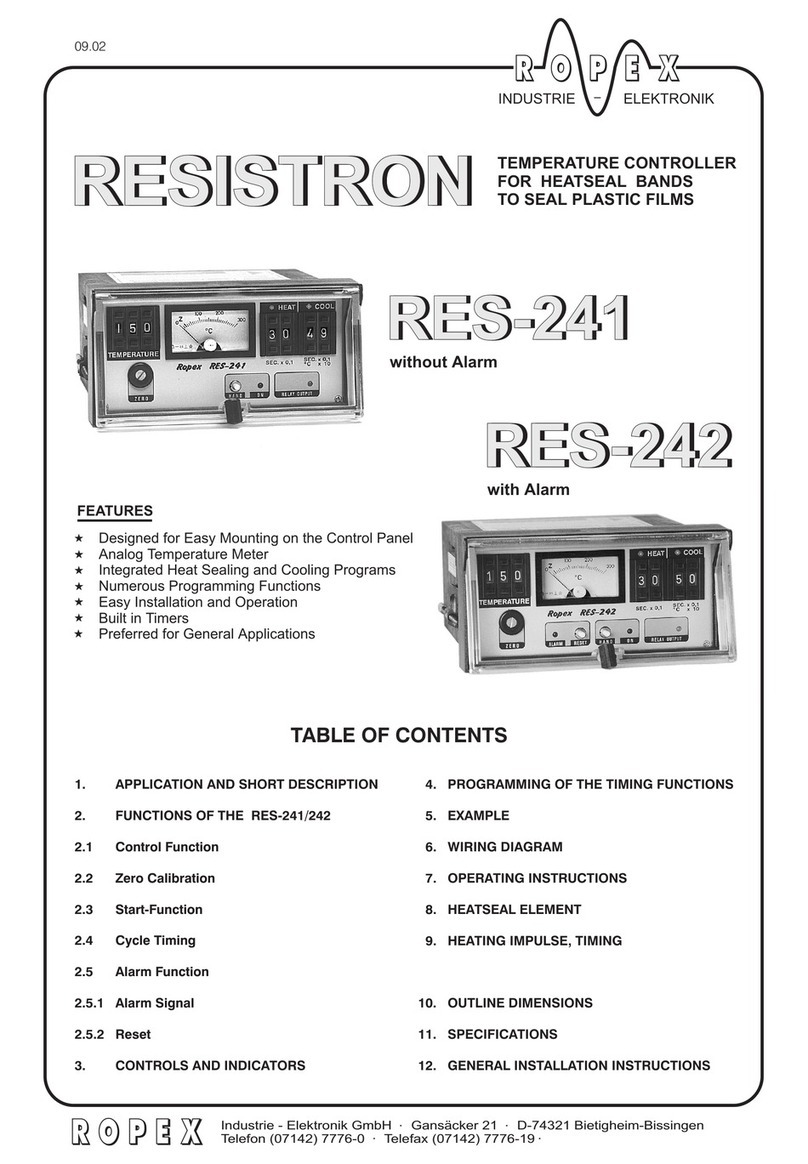
Ropex
Ropex Resistron RES-242 User manual
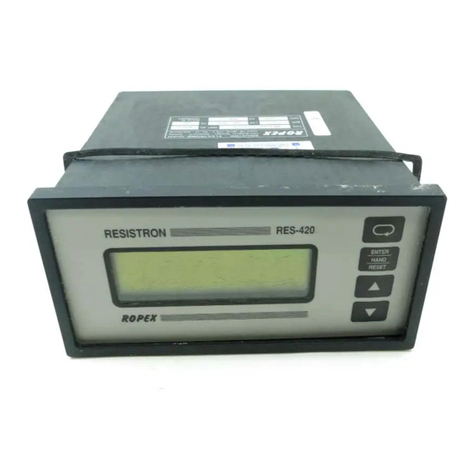
Ropex
Ropex RESISTRON RES-420 User manual

Ropex
Ropex Resistron RES-220 Quick start guide
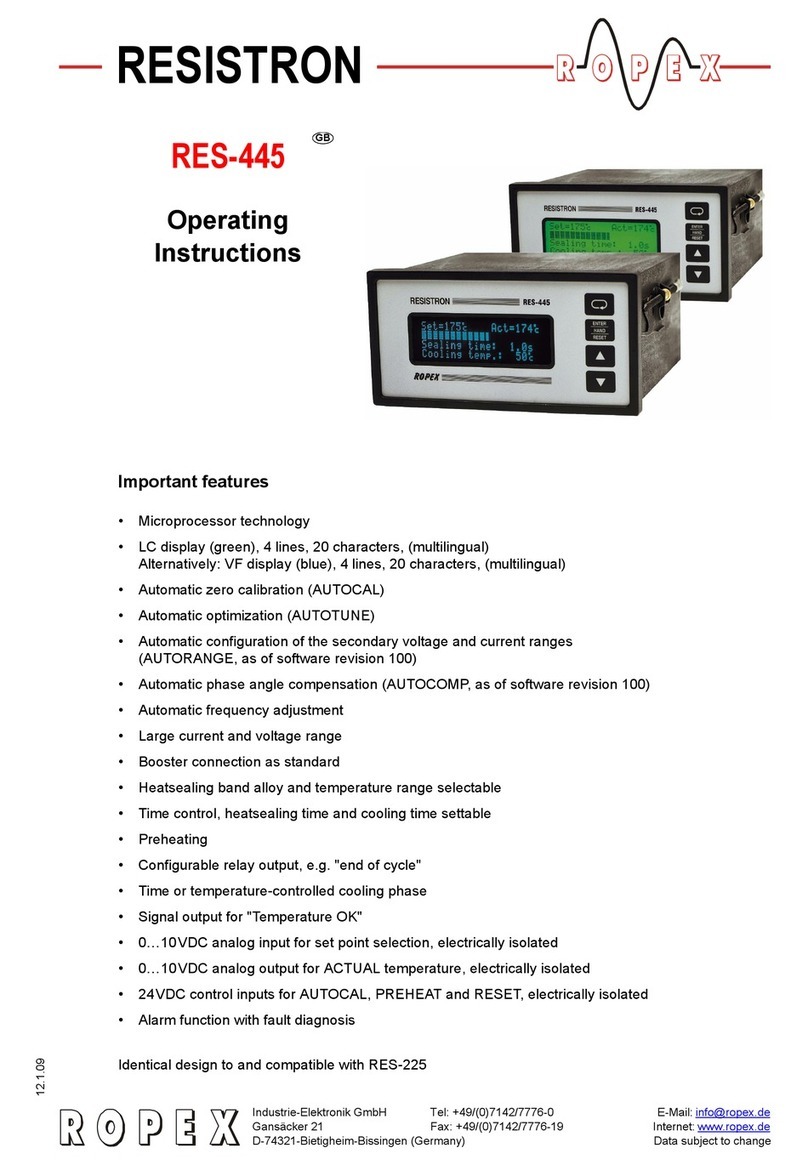
Ropex
Ropex RES-225 User manual

Ropex
Ropex RESISTRON RES-409 User manual
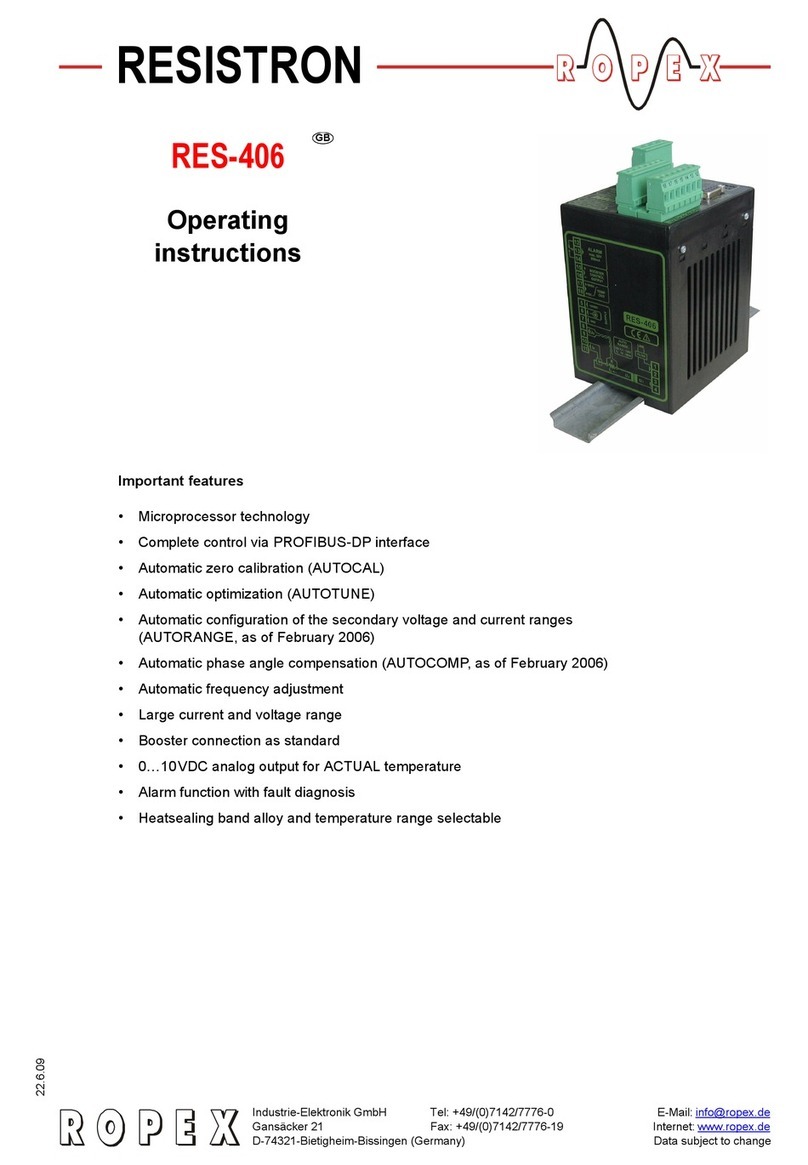
Ropex
Ropex RESISTRON RES-406 User manual
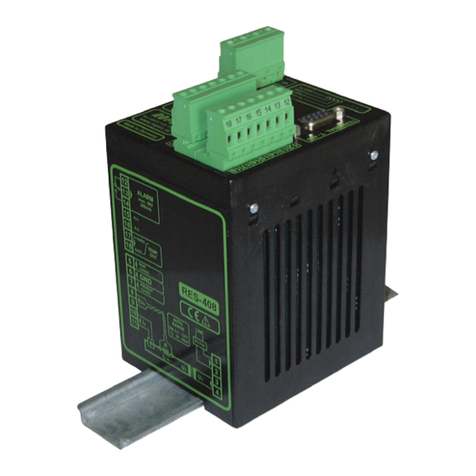
Ropex
Ropex RESISTRON RES-408 User manual
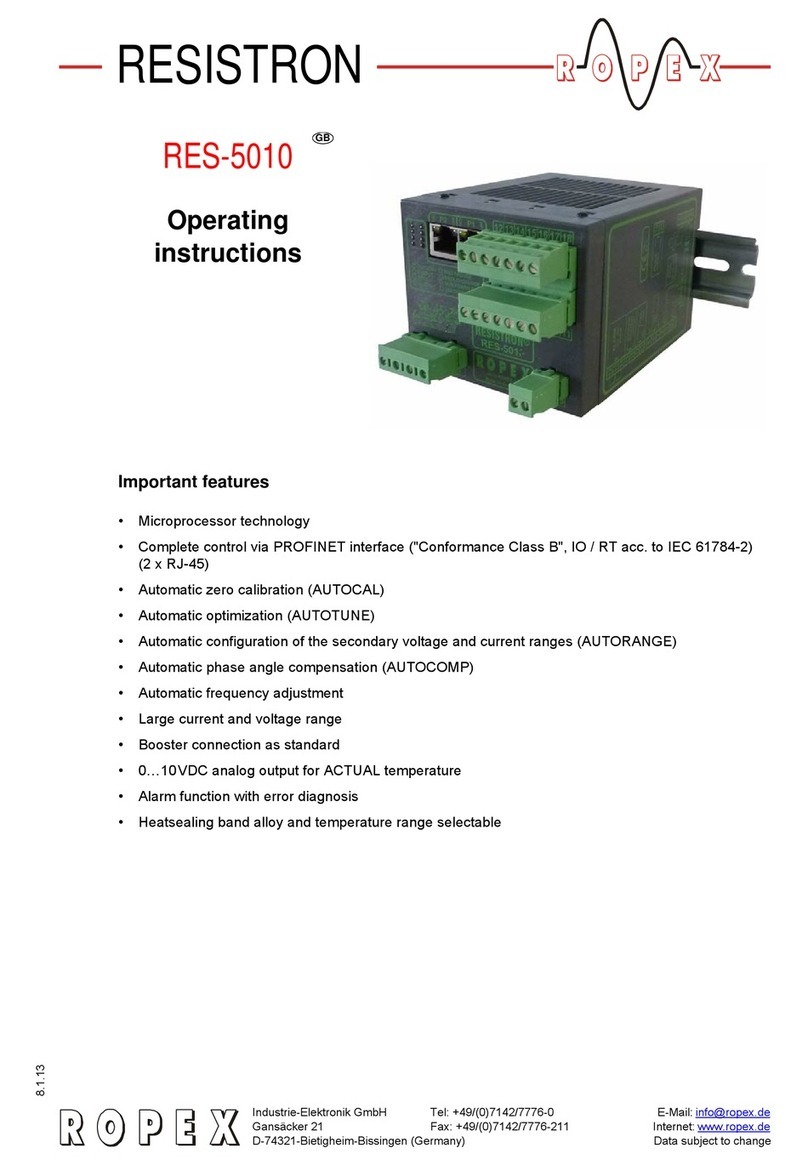
Ropex
Ropex RESISTRON RES-5010 User manual
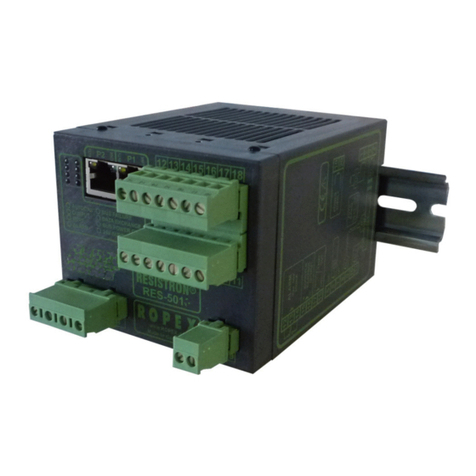
Ropex
Ropex Resistron RES-5011 User manual
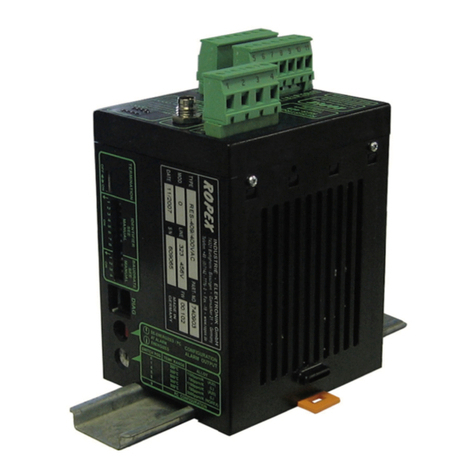
Ropex
Ropex RESISTRON RES-409 User manual
